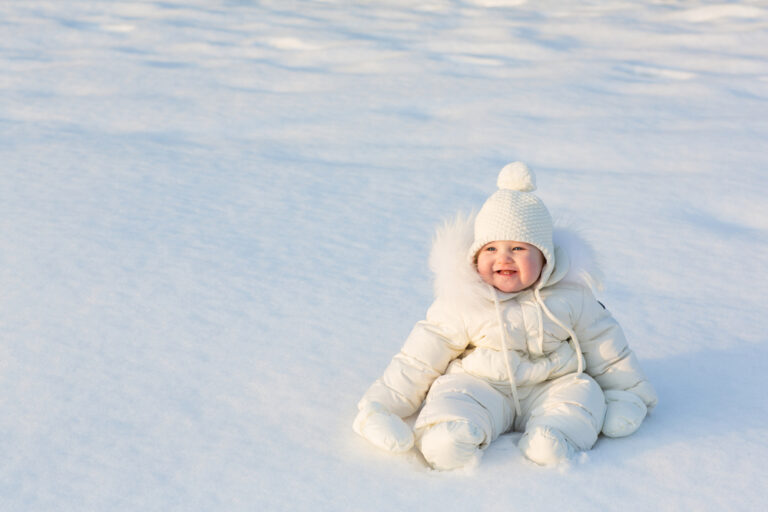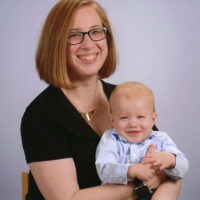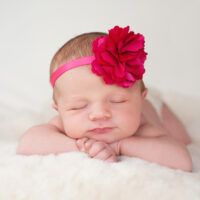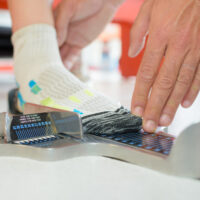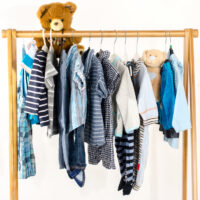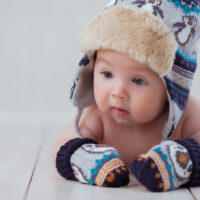Babies can’t tell us when they’re too hot or too cold, so you may be wondering how to dress your baby in the winter months. Newborns and young babies are not able to regulate their body temperature as well as children and adults, which makes it especially important that you dress them warm enough. Keep reading for our recommendations on how to appropriately dress your baby in the winter.
Dressing for Indoors
A couple of layers should be enough to keep your baby comfortable inside during the winter months. Footie pajamas are a good first layer since they will keep the whole body, and toes, nice and toasty. You can layer with a fleece one-piece, a sweater, or a sweatshirt. Many bodysuits come with flaps that can be put over your baby’s hands if you are headed outside or feel that they need a little extra warmth. You can always layer socks under footie pajamas, or bootieson top for additional warmth as well.
If you opt for pants and a shirt, layer with socks or booties, and a sweatshirt or sweater. As the house warms up during the day, or you have an especially active little one, you can always take a top layer off if you feel your baby is warm enough. If you find that you’re grabbing for a blanket or sweatshirt, chances are your baby is chilly too and may need that extra layer.
If you’re bundled up from outside and coming back into the house, make sure to take the extra layers off of your baby. Babies are not able to regulate their body temperature as well as adults, so it will be hard for them to regulate themselves from overheating if you keep all their layers on when returning to the nice and warm house. Similar to adding layers before going out, the best practice is to remove layers once coming in.
Dressing at Night
Sleeping during the winter be a tricky scenario since it is not recommended that babies have blankets in their beds. In addition, the NIH suggests that multiple layers of heavy clothing, heavy blankets, and warm room temperatures lead to an increased risk of SIDS. So what’s the best way to keep babies warm in the winter?
You should dress your baby in light clothing for sleeping and keep the room at a comfortable temperature. Instead of blankets, you can use a swaddle, sleep sack, or wearable blanket with pajamas underneath.
Determining the room temperature can be challenging, just remember that a baby that feels hot to the touch is in danger of overheating. You want the room to be comfortable to an adult, which might be warmer than your preferred sleeping temperature since adults are used to burrowing under sheets and blankets. If your baby’s hands feel cold, bump up the temperature a few degrees.
If you co-sleep with your baby, even fewer layers are necessary as your body heat will provide extra warmth. Likely they will only need cotton or fleece footie pajamas to stay comfortable.
Dressing for Outdoors
If you’re headed outside in frigid temps, an example of appropriate layers for a baby would be socks under footie pajamas, a long-sleeved shirt, pants, a sweater, a toasty snowsuit, mittens, and a hat. The hat and mittens are important accessories. Even if you’re just going to be outside for a short period of time. Babies lose most of their heat through their heads, and tiny fingers that are exposed to winter temps can become susceptible to frostbite. We recommend a hat that covers the ears. A chin strap that prevents your baby from being able to remove it too easily is also a great idea.
If you’re planning a walk in the stroller you can tuck your baby in with a fleece blanket. But wait until the straps are buckled first. Stroller bunting bags are another great option. Almost like a waterproof baby sleeping bag, stroller bunting bags attach to the stroller allowing the straps to be threaded through. You can then zip your baby inside, keeping them warm and toasty. As your baby grows, this can be a foot and leg cover for toddlers as well. You will get years of use out of this winter accessory.
Carseat Safety
If you’re heading off on an adventure in the winter, it’s important to remember not to put your baby into the car seat in bulky layers. A snowsuit or puffy coat can cause car seat straps to be too loose, preventing your baby from being buckled in safely. Instead, place your baby into the car seat in their regular outfit, and use blankets over the straps. If you’re able to warm the car up ahead of time, you won’t have to worry about your baby adjusting quite as much to a fluctuation in temperatures. Remove hats that can be pulled down or that have tied chin straps as well to prevent any hidden dangers.
FAQs – How to Dress Your Baby in the Winter
Even with layers, why are my baby’s hands cold?
Baby’s hands, and sometimes feet, can feel cold even when their body is warm enough. As a baby’s body develops, this will begin to regulate. Hands and feet are the part of their body that the blood gets to last. Before adding extra layers, feel the back of your baby’s neck or belly for a better indication of their body temperature.
What temperature should a baby’s room be at night?
The room should feel comfortable to an adult, which is generally around 65°F-68°F. Keeping the room comfortable means you won’t worry about dressing your baby in heavy layers to keep them cozy.
Should you take a baby outside in the winter?
Absolutely, even if it’s for a short walk the fresh winter air is great for babies. Now that you’re equipped with information about how to dress your baby for the winter, don’t be nervous! They may not be interested in playing in the snow or going for a ride down the neighborhood sledding hill, but don’t shy away from some fresh clean winter air.
How do you know if your baby is cold?
Hands and feet are not always a good indicator of how a baby is feeling, as they may run colder than the rest of their body. If you don’t want to undress your baby or disturb them too much when they are sleeping, feel the back of their neck. It should feel warm, not hot or cold. If your baby’s skin appears very pale, or they are shivering, then this indicates that they are too cold and need additional layers.
Wrap Up
Figuring out how to keep your baby comfortable can feel overwhelming, but it doesn’t have to. Visually observe them for signs such as flushed cheeks, pale skin, sweating, or shivering. Feel the back of their neck, if it feels hot, sweaty, or clammy, it’s time to take off some layers. If they feel cold or are paler than normal, it might be time to add a layer or two.
If you’re heading off on a winter adventure, pick appropriate layers, and bring extras! Wet layers will not keep a baby warm. All it takes is a leaky diaper or a teething baby to soak through their clothes. Keep spare mittens and hats in a bag as well, as those can quickly get left behind or forgotten.
Utilizing layers is your best bet when it comes to dressing your baby in the winter. Layers allow you to easily add additional warmth or remove some heat to find the best level of comfort for your baby. Think of the number of layers you are wearing, and consider adding at least one additional layer for your baby.
